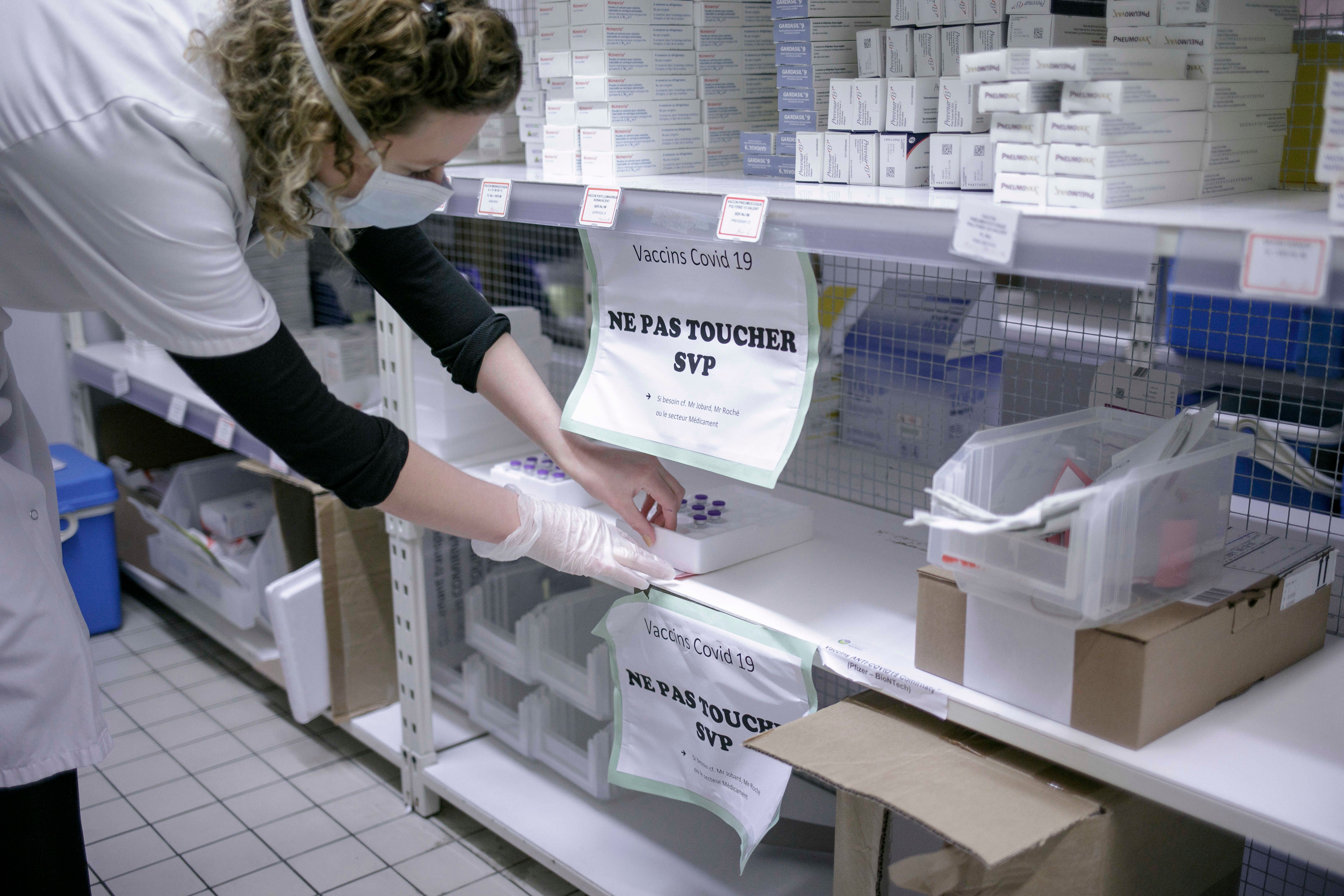EU’s Slow Start in the Vaccine Race

Based on the number of doses administered per 100 citizens, the EU (5.2) trails Israel (79.5), the UK (24.3), and the U.S. (16.8). The Member States claim that is due to insufficient deliveries of vaccines by pharmaceutical companies.
Vaccine Negotiations
By late spring 2020, the EU Member States had decided to negotiate with producers as a bloc, aiming to boost their bargaining power and, most importantly, avoid inter-EU competition for vaccines. The latter could result in unequal access to doses, lead to political strife, and disturb the functioning of the single market. The details of how the EU would negotiate with the companies were settled only in June 2020 after talks carried out with pharma companies by a group of Member States provoked nervous reactions from others. In the meantime, the UK and the U.S. reached their first deals, striking in May an agreement with the British-Swedish consortium AstraZeneca (AZ), and in July with the alliance of the American Pfizer with German BioNtech.
The EU negotiations were conducted by the European Commission (EC), supported by a steering committee staffed by representatives of all Member States. Between August and November 2020, contracts were signed with six pharmaceutical companies giving Member States the right to buy up to 2 billion doses (see Table 1 below). These will be delivered gradually in 2021, with Member States being allocated batches according to population. Prices and delivery timetables were not officially disclosed but leaks suggested that the EU got significantly lower prices than the U.S. and the UK. In parallel, the EU supported actions under the aegis of the WHO to finance vaccines for less affluent countries.
EC representatives stressed that the negotiations, especially with the American companies, bogged down on the issue of liability. Unlike the U.S. and the UK, the EU refused to take on all liability for possible side effects provoked by the inoculations. The European Medicines Agency (EMA) was very scrupulous in evaluating the vaccines. In the case of Pfizer’s, the review took 21 days. The British equivalent of the EMA granted emergency authorisation in just nine days. The EC emphasised that the hasty certification and what it considered a lax approach to producers’ liability could deepen public scepticism towards the vaccines, which in several Member States was much deeper than in the UK. Following the authorisation of the Pfizer jab, the vaccination process started in the EU on 26-27 December, two weeks later than in the U.S. and nearly three weeks after the British. Two more vaccines, one produced by AZ and another by Moderna, an American company, were certified by the EU in January.
Supply Problems
In mid-January, Pfizer informed recipients that it would reduce deliveries, including to the EU, claiming that it was necessary in order to change its factory in Belgium to increase output. Several Member States reported that Moderna too had supplied fewer doses than expected. The most troubling, however, were the cuts announced by AZ, whose jabs were to constitute the majority of doses received in the EU in the first quarter of 2021. While Pfizer asserts that despite temporary delays it will fulfil its obligations in the first quarter, AZ reported that it would deliver only 40-50% of the doses agreed in the contract for that period (which is about 40 million less than planned), pointing to problems with the production process at its plant in Belgium. Many analysts argued that producers would be more determined in their efforts to increase output had the EU agreed to higher prices. The Commission claims that the reasons presented by the company do not justify the large shortfall, and that it unduly delayed reporting about production glitches. The EU then demanded that, to fulfil the contract, doses produced in the company’s facilities in the UK be delivered to the EU. AZ, however, maintains that its obligations towards the UK, agreed earlier, take precedence. It is probable that even if AZ were willing to reduce British deliveries to minimise the shortfall in the EU, the UK government would prevent export of the doses.
Solutions
In reaction to the problems, the EC introduced a procedure for export control. For a company to ship inoculations manufactured in the EU abroad, they will have to provide data on doses produced and exported since late October 2020. The EU is ready to block the export of doses if a company does not meet its contractual obligations towards the Community. By doing so, it could, however, provoke retaliatory measures (e.g., from the UK) and encourage other countries, such as India where a lot of key ingredients for inoculations are produced, to take similar steps.
Efforts to increase production are less controversial. The EC set up a task force that will look for ways to achieve this goal in close cooperation with pharma companies. A relatively quick remedy would be to engage other firms in the production process. Several left-wing politicians have been pleading for the suspension of patents, which would pave the way for increasing the number of entities that could start production. In addition, the likely imminent authorisation of new vaccines will increase demand.
Member States are allowed to buy vaccines from producers with whom the EC did not negotiate and administer them based on approvals from national regulators. Hungary used this right to order 2 million doses of the Russian Sputnik V jab along with 5 million Chinese vaccines. It is, however, doubtful, whether Russia will be able to provide its doses in large numbers soon.
Conclusions and Prospects
By negotiating in common, the Member States gained access to vaccines at the same time and price. Even though producers are responsible for the reduced deliveries, the EC and Member States did not properly scrutinise their actions, which could have led to earlier detection of problems and triggered a search for solutions. Meanwhile, the information that the EU had secured a large number of doses, strongly emphasised by the EC, could have given the public the incorrect impression that the vaccination process would be swift and smooth. Problems related to the production and delivery of vaccines lend validity to calls expressed by several Member States (including Poland) and EU institutions to boost European production capacity in strategic sectors and to ensure wide and diversified access to raw materials. Even though EU companies are part of the consortia that were the first to produce vaccines, the main role is played by entities that have closer ties to the UK and the U.S.
Given limited access to information about the contracts and to avoid speculation and disinformation, Member States should regularly report on the status of vaccines: expected, delivered, and administered. The first quarter of 2021 could be used to adjust the logistics of the process to speed it up once supply improves.
In the long term, the supply of vaccines most likely will be sufficient to achieve the goal set by the EC to vaccinate 70% of adults (around 255 million) by 21 September 2021 (7.5 million have been vaccinated so far). In the second quarter, the Commission expects 300 million doses, but if deliveries increase significantly only towards the end of that period, the Member States will not manage to vaccinate so many people before the deadline.
Further delay of the vaccination process will provoke economic losses as lockdowns will be prolonged. That will prevent the Union from building on the success it found in maintaining unity in the procurement of vaccines and could undermine public support for governments and community institutions. In the international arena, current problems complicate the Union’s plans to provide vaccines to other countries, its neighbours in particular. China and Russia aim to surpass the EU in this respect but face similar production problems.
Table 1. Vaccines Procured by the European Union
|
Producer |
Number of doses (millions) |
Date of the agreement (2020) |
Status |
|
Pfizer/BioNTech |
200+100* 200+100** |
November |
Authorised for use |
|
Moderna |
80+80 |
November |
Authorised for use |
|
AstraZeneca |
300+100 |
August |
Authorised for use |
|
Johnson & Johnson |
200+200 |
October |
Under EMA review |
|
Curevac |
225+180 |
November |
Under EMA review |
|
Sanofi-GSK |
300 |
September |
Clinical trials |
|
Novavax |
200 |
Preliminary talks concluded |
Under EMA review |
|
Valneva |
60 |
Preliminary talks concluded |
Clinical trials |
* The agreements spelled out the number of doses the EU was obliged to buy and an option to buy additional doses.
** The agreement for 300 million additional doses was concluded in January 2021.


